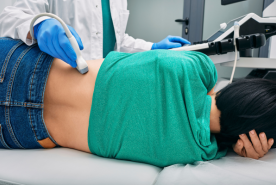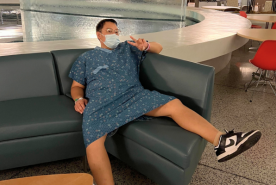Last updated: October 10, 2025
Medically reviewed by: NKF Patient Education Team
Learn how CKD affects children and teens, including causes, symptoms, treatment, and support for healthy growth.
Table of Contents
- Chronic Kidney Disease in Children and Teens
- Causes of CKD in Children and Teens
- Signs and Symptoms of CKD in Children and Teens
- How CKD is Diagnosed
- Treatment Options
- Eating Well with CKD in Children and Teens
- Living with CKD as a Child or Teen
- Supporting Families and Caregivers
- Questions to Ask Your Child’s Doctor
Chronic Kidney Disease in Children and Teens
Chronic kidney disease (CKD) means the kidneys have been damaged for at least 3 months and are not working as well as they should. Kidneys have many important jobs that keep a child healthy and growing.
- Remove waste and extra water: Kidneys act like filters. They clean the blood and make urine.
- Help make red blood cells: Kidneys send signals to the body to make red blood cells. These carry oxygen, which gives energy.
- Balance minerals: Kidneys keep the right amount of sodium, calcium, and potassium. These help the heartbeat, muscles move, and bones stay strong.
- Control blood pressure: Kidneys help keep blood pressure in a healthy range.
- Support strong bones: Kidneys help the body use vitamin D, which keeps bones healthy.
When CKD makes these jobs harder, children may have growth delays, learning problems, or other health issues. Finding CKD early and starting treatment helps protect health.
- CKD can raise the risk of other problems, like heart disease and stroke. Many children do not have symptoms at first. If CKD gets worse, the kidneys may stop working, and dialysis or a kidney transplant may be needed.
- Although CKD is more common in adults, children and teens can also get it. Because their bodies are still growing, CKD can affect height, weight, puberty, school, and daily life. Early diagnosis and treatment help protect kidney function, support healthy growth, and let kids stay active at school and with friends.
Causes of CKD in Children and Teens
Children and teens can develop CKD for many reasons. Some are present at birth. Others develop later from illness or other health conditions. Knowing the cause helps doctors choose the best treatment and plan for the future.
- Birth defects: Some children are born with kidneys that did not develop fully, or with urinary tract problems.
- Genetic or inherited kidney diseases: These are conditions passed down from parents to their children. More than 60 inherited diseases can cause CKD. Some examples include polycystic kidney disease (PKD), Alport syndrome, Fabry disease, primary distal renal tubular acidosis (dRTA), and primary hyperoxaluria type 1 (PH1).
- Infections or immune system problems: Conditions like lupus or severe infections can damage the kidneys.
- Blockages or urine flowing backward (reflux): These problems can strain the kidneys and cause lasting harm.
- Other health conditions: Teens with diabetes or high blood pressure can develop CKD if these conditions are not controlled.
Signs and Symptoms of CKD in Children and Teens
Children and teens may not have any noticeable symptoms in the early stages of CKD. Kidney disease often develops slowly, and signs may only appear as the condition gets worse. Paying attention to these changes can help families and doctors catch problems earlier and start treatment to protect kidney function.
- Swelling or puffiness around the eyes, feet, ankles, legs, or hands: This happens when the kidneys cannot remove extra fluid from the body.
- Foamy urine (pee): Bubbles or foam in urine can be a sign that protein is leaking from the kidneys.
- Pink or brown colored urine: This may mean blood is present in the urine, which can signal kidney damage.
- Urinating (peeing) more often or less often than usual, some children may get wet the bed at night. Changes in urination can be one of the earliest signs of kidney problems.
- Loss of appetite: CKD can cause nausea or a reduced desire to eat, which may affect growth.
- Feeling tired: Anemia (low red blood cell count) or waste buildup in the blood can make children feel weak or exhausted.
- Frequent bad headaches: High blood pressure is common with CKD and may cause headaches.
- Stunted or poor growth compared to others in their age group: CKD can affect how the body uses nutrients, slowing height and weight gain.
- Trouble focusing and doing poorly in school: Fatigue, anemia, or changes in electrolytes can affect attention and learning.
How CKD is Diagnosed
Because symptoms are not always clear, tests are important for finding CKD in children and teens. Doctors may order several types of tests to check kidney structure and function. These results guide treatment and help track whether the disease is changing over time.
- Blood tests to measure kidney function, such as creatinine and eGFR: These tests show how well the kidneys are filtering waste from the blood and help determine the stage of CKD.
- Urine tests to check for protein, blood, or other changes: Extra protein or blood in the urine can be an early sign of kidney damage, even before symptoms appear.
- Imaging tests (ultrasound or scans) to look at kidney size, shape, and position: Pictures of the kidneys help doctors see birth defects, blockages, or scarring that may be causing problems.
- Genetic testing if an inherited kidney condition is suspected: This can confirm whether CKD is caused by a genetic condition, which may affect treatment choices and help with family planning.
What to Expect at the Doctor’s Office
Most tests for CKD are simple and not painful. Blood tests involve a quick blood draw. Urine tests usually require your child to provide a small urine sample. Imaging tests like ultrasounds are painless and use sound waves to take pictures of the kidneys. If genetic testing is needed, it is often done with another blood or saliva sample.
Treatment Options
Treatment for CKD in children and teens focuses on slowing kidney damage, treating symptoms, and supporting growth and development. The treatment plan depends on the stage of CKD, the cause, and the child’s overall health.
- Medications to control blood pressure, anemia, or bone health: These can help protect the kidneys, improve energy levels, and support bone growth. Some medicines may also lower protein in the urine, which helps slow kidney damage.
- Nutrition guidance from a kidney dietitian to support growth and reduce strain on kidneys: A dietitian helps families plan meals that provide enough calories and protein for growth while limiting certain nutrients, like sodium or phosphorus, if needed.
- Dialysis if the kidneys stop working well enough to keep the body healthy: Dialysis removes waste and extra fluid when the kidneys can’t. Children may receive hemodialysis in a clinic or peritoneal dialysis at home, depending on what is best for their health and lifestyle.
- Kidney transplant as a long-term treatment option for kidney failure: A transplant can provide the closest thing to normal kidney function and allows many children to return to school, sports, and daily activities with fewer restrictions.
Eating Well with CKD in Children and Teens
Food choices play a major role in helping children and teens with CKD grow and stay healthy. Because their bodies are still developing, nutrition needs are different from adults with kidney disease. The challenge is balancing enough calories and protein to support growth while protecting the kidneys from extra strain. A kidney dietitian is an important partner who can help create realistic and flexible meal plans that work at home, at school, and during activities.
- Making sure children get enough calories and protein for growth: CKD can sometimes lower a child’s appetite or change how their body uses nutrients. A dietitian can suggest foods that provide the right balance of energy and protein to help kids grow taller, build muscle, and stay active.
- Limiting sodium, phosphorus, or potassium if needed: Some children may need to limit certain minerals to prevent swelling, protect bones, or keep the heart healthy. This is different for each child, so guidance is tailored to their lab results and stage of CKD.
- Planning meals and snacks that fit into school, sports, and family routines: Kids and teens with CKD can still enjoy meals and snacks with friends and family. Dietitians help families adjust recipes, lunchbox options, or after-school snacks so children can participate fully while staying kidney-friendly.
Living with CKD as a Child or Teen
CKD is more than a medical condition; it can affect nearly every part of a young person’s life. Children and teens may face challenges at school, in friendships, and with emotional health as they adjust to managing a chronic illness. With the right support, however, they can thrive, stay active, and build the skills they need for independence as they grow.
- Regular check-ups with the care team to monitor kidney health: Ongoing visits help doctors track kidney function, adjust medications, and watch for growth or developmental changes.
- School support through a 504 plan or Individualized Education Program (IEP): These plans ensure children with CKD get accommodations, like extra bathroom breaks, nutrition support, or flexibility for medical appointments, so they can succeed in school.
- Counseling or peer support groups for children, teens, and families: Talking with a counselor or connecting with other kids who have CKD can reduce feelings of isolation and help families cope with stress.
- Guidance for teens on managing medications and preparing to move to adult care: As teens get older, learning to manage prescriptions, track lab results, and advocate for themselves prepares them for a smooth transition to adult doctors and care systems.
Supporting Families and Caregivers
Caring for a child or teen with CKD can be overwhelming. Parents and caregivers often juggle medications, doctor visits, school needs, and nutrition changes while also managing jobs and family responsibilities. Having strong support systems in place helps reduce stress and allows caregivers to focus on their child’s health while also caring for themselves.
- Learning how to manage medicines, lab results, and nutrition plans: Caregivers often become the coordinator of care, keeping track of prescriptions, test results, and dietary needs. Education and tools from the care team can make these responsibilities easier to manage.
- Finding financial or social work resources to help with care costs and insurance: Social workers and hospital support staff can connect families with insurance guidance, financial aid, and community programs to reduce the burden of medical expenses.
- Taking care of their own health and well-being: Caregivers need rest, support, and time for themselves. Maintaining their own physical and emotional health helps them provide steady, long-term support for their child.
Questions to Ask Your Child’s Doctor
Asking questions helps parents, caregivers, and teens better understand CKD and prepare for the future. Bringing a list of questions to appointments can make visits more effective and less stressful.
- What is causing my child’s CKD?
- How often should we have check-ups and lab tests?
- What nutrition changes do we need to make?
- What are the treatment options now and in the future?
- How can we support school and daily life?
- When should we start talking about dialysis or transplant?

















